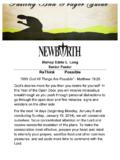Transcription of Rediscovering Market Segmentation - Viewpoint Learning
1 This article is made available to you with compliments of Daniel Yankelovich. Further posting, copying or distributing is copyright infringement. To order more copies go to Rediscovering Market Segmentation by Daniel Yankelovich and David Meer The psychographic profiling that passes for Market Segmentation these days is a mostly wasteful diversion from its original and true purpose discovering customers whose behavior can be changed or whose needs are not being met. Reprint R0602 GThis article is made available to you with compliments of Daniel Yankelovich. Further posting, copying or distributing is copyright infringement. To order more copies go to Rediscovering Market Segmentation by Daniel Yankelovich and David Meer harvard business review february 2006page 1 COPYRIGHT 2006 HARVARD BUSINESS SCHOOL PUBLISHING CORPORATION. ALL RIGHTS RESERVED. The psychographic profiling that passes for Market Segmentation these days is a mostly wasteful diversion from its original and true purpose discovering customers whose behavior can be changed or whose needs are not being met.
2 There are many different kinds of people, andthey display about as many different buyingpatterns. That simple truth is well understoodby those responsible for Market research,product development, pricing, sales, and strat-egy. But they haven t been getting much helpfrom a venerable technique Market segmen-tation which, if properly applied, wouldguide companies in tailoring their productand service offerings to the groups most likelyto purchase them. Instead, Market segmenta-tion has become narrowly focused on theneeds of advertising, which it serves mainly bypopulating commercials with characters thatviewers can identify with the marketingequivalent of central casting. This is hardly the state of affairs we antici-pated 40 years ago when one of us introducedthe concept of nondemographic segmentationin HBR as a corrective to the narrow relianceon purely demographic ways of grouping con-sumers.
3 In 1964, in New Criteria for MarketSegmentation, Daniel Yankelovich assertedthat: Traditional demographic traits such as age,sex, education levels, and income no longer saidenough to serve as a basis for marketing strategy. Nondemographic traits such as values,tastes, and preferences were more likely to influ-ence consumers purchases than their demo-graphic traits were. Sound marketing strategy depended onidentifying segments that were potentially recep-tive to a particular brand and product category. The idea was to broaden the use of segmen-tation so that it could inform not just advertis-ing but also product innovation, pricing,choice of distribution channels, and the today s segmentations do very little of this,even though markets and media are, if any-thing, even more fragmented today than theywere in 1964 and consumers even more diverseand accustomed to following their own tastesand impulses.
4 Segmentation can do vastly more than serveas a source of human types, which individuallygo by such colorful monikers as High-TechHarry and Joe Six-Pack and are known collec-This article is made available to you with compliments of Daniel Yankelovich. Further posting, copying or distributing is copyright infringement. To order more copies go to Rediscovering Market Segmentation harvard business review february 2006page 2 Daniel Yankelovich is chairman of Viewpoint Learning , a firm that pro-motes problem solving through dia-logue, and DYG, a Market research firm that tracks social trends. He is based in San Diego. David Meer is a partner in the New York office of Marakon Associates, an international strategy consulting firm. tively by the term psychographics. Psycho-graphics may capture some truth about realpeople s lifestyles, attitudes, self-image, and as-pirations, but it is very weak at predicting whatany of these people is likely to purchase in anygiven product category.
5 It thus happens to bevery poor at giving corporate decision makersany idea of how to keep the customers theyhave or gain new ones. The failings of psychographics, however, andthe disappointments it has produced in its us-ers, should not cast doubt on the validity ofcareful Segmentation overall. Indeed, Market -ers continue to rely on it, and line executivesincreasingly demand segmentations that thewhole enterprise can put into action. Becauseof the technique s underlying validity, andmanagers continuing need for what it can do,there s good reason to think that segmenta-tion s drift from its original purpose and po-tency can be halted. Good segmentations iden-tify the groups most worth pursuing theunderserved, the dissatisfied, and those likelyto make a first-time purchase, for are dynamic they recognize that thefirst-time purchaser may become underservedor dissatisfied if his or her situation they tell companies what products toplace before the most susceptible consumers.
6 In this article, we ll describe the elements ofa smart Segmentation strategy. We ll explainhow segmentations meant to strengthen brandidentity and make an emotional connectionwith consumers differ from those capable oftelling a company which markets it shouldenter and what goods to make. And we ll intro-duce a tool we call the gravity of decision spec-trum, which focuses on the form of consumerbehavior that should be of greatest interest tomarketers the relationship of consumers to aproduct or product category, not to their jobs,their friends, their family, or their community,all of which lay in the realm of psychographics. The Drift into Nebulousness The years after World War II were marked byextraordinary innovations in consumer prod-ucts transistor radios, disposable diapers,razor cartridges, pleasant-tasting sugarless co-las, among them. For products so ground-breaking and widely desired, advertising didnot have to do much more than announcetheir existence and describe their dazzlingfeatures.
7 By the early 1960s, however, consumerswere becoming less predictable in their buyinghabits: Many people without much educationhad become affluent; others with sophisticatedtastes had become very price conscious. As aresult, tastes and purchasing patterns nolonger neatly aligned with age and income,and purely demographic segmentations losttheir ability to guide companies decisions. As time went on, product introductions re-mained frequent, but they increasinglyamounted to refinements of existing offeringsthat had originally answered real consumerneeds but now merely catered to mild prefer-ences. With ever more trivial improvements toreport on, and few ways to distinguish a cli-ent s product from the competition s, advertis-ing grew boring and bored with itself. Gradu-ally, the focus of creative departments shiftedfrom the product to the consumer: If, by the1970s, products had become less distinctive,people seemed to be bursting with unprece-dented variety.
8 One way companies found to convince par-ticular groups of consumers that a product wasperfect for them was to place in the advertisingmessage a person whom they resembled orwished they did. Another way, which followedfrom the consumer orientation of the first, wasto emphasize the emotional rather than thefunctional benefits products offered pride ofownership, increased status, sex appeal. Cakemixes to which a fresh egg had to be added, forexample, may have tasted no better than ear-lier versions containing powdered egg. Butthey sold well because the extra step allowedthe preparer to feel she was fulfilling a wife straditional domestic role. In contrast to break-through products such as an effective over-the-counter dandruff shampoo that addressedintense unmet needs, ordinary third-generationproducts had to find customers who were al-ready and especially susceptible to their the attraction was based on things likestatus, it made sense to fashion segments re-flecting the personal characteristics and life-styles of the target consumers.
9 As competitorsincreased the speed and skill with which theycould copy or reengineer products, the func-tional dimension of existing offerings becameless compelling. Ironically, by the mid-1970s,belief in the power of imagery to stimulatesales of dull items may have begun to takepressure off product developers to come upThis article is made available to you with compliments of Daniel Yankelovich. Further posting, copying or distributing is copyright infringement. To order more copies go to Rediscovering Market Segmentation harvard business review february 2006page 3 with products and services displaying genu-inely innovative technology and fresh design,thus aggravating the problem. Two concurrent developments gave thisnew emphasis on the consumer s self-concep-tion, emotions, and personality an extra mea-sure of rigor. Social scientists began to applytheir modes of analysis to business problems,and business executives, confused by the frag-mentation of the mass audience and thespeed with which tastes were changing, wel-comed their insights.
10 Using attitudinal indica-tors similar to those elicited by personalitytests, psychologists carved out marketing seg-ments based on their members sharedworldview. Those early segments were popu-lated with the Inner-Directed, Traditionalists,Hedonists, and the like. In 1978, Arnold Mitchell and his colleaguesat the Stanford Research Institute launchedthe Values and Lifestyles (VALS) program, acommercial research service, which was soonretained by scores of consumer product com-panies and advertising agencies. VALS drewheavily on frameworks developed by Harvardsociologist David Riesman, coauthor of TheLonely Crowd, and Brandeis psychologist Abra-ham Maslow, who posited the now well-knownhierarchy of needs. VALS classified individualsaccording to nine enduring psychologicaltypes. An individual consumer s behavior, thetheory went, could in turn be explained by hisor her correspondence to one of those and similar models soon turned psycho-graphics into the most accepted mode of seg-mentation.







